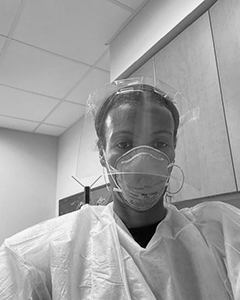In this issue, we talked to Dr. Carla Watson of the OSF Little Company of Mary Medical Center in Evergreen Park, IL. Dr. Watson made a big transition when COVID-19 hit and directly treated patients that tested positive. The following article is based on her experience as of late June 2020.
 Carla Watson, MD, FAAPMR
Carla Watson, MD, FAAPMR
Physician Advisor
OSF Little Company of Mary Medical Center
As a board-certified physiatrist within the OSF Little Company of Mary Medical Center in Evergreen Park, IL, I wear several hats on a day-to-day basis. 50% of my time is spent doing clinical work, which usually involves in-patient consults for anyone needing to have a rehabilitation consult as well as outpatient EMGs and nerve studies. The other 50% deals mostly with case management in terms of discharge planning of difficult cases, utilization reviews, length of stays, and more.
As COVID-19 swept through the state of Illinois, our number of cases accelerated daily. The Chicago zip code we serve was labeled a "hotspot." Our daily goals changed from seeing patients to securing the hospital as ICU and PCU wards overflowed with COVID-19 positive patients.
Instead of performing EMGs, my focus shifted to evaluating patients with COVID who potentially qualified for in home monitoring to create available beds which were scarce. A lack of PPE and the need to limit access to patients meant coming up with a plan to restructure how we performed our duties.
We even restructured how our practitioners entered the building in order to decrease contact and flow of people entering the hospital.
Naturally, there was a pause in the need for inpatient rehabilitation consults. Our referring IRFs and SNFs weren't yet prepared to accept COVID-19 patients early on. There were no guidelines on how to proceed. As an advisor to case management, our big issue was where to send these patients that needed to transition out of acute care but could not go home.
Collaborating with the SNFs, we were able to help develop rules, regulations, and guidelines with the state to say, "Okay, if you do this, this is how you would be able to safely accept the patient." While this has helped, it's still an ongoing process to direct people to care and get them access to care. The care that we, as physiatrists, are seeing develop before our very eyes.
In PM&R, usually be the time they get to us, we have a fairly clear rehab diagnosis, whether it's stroke, amputation, TBI, etc. We have enough experience and data on just how hard to push these patients for desired outcomes. With COVID-19, we've had to take a more cautious approach. Patients could take three steps forward only to take another five steps back.
At OSF Little Company of Mary Medical Center, the majority of COVID-19 patients were too sick for rehab. We saw two extremes: those who were on and off the ventilator fighting for their lives and those who were really sick but needed to move a little bit. For the latter, it was about finding a balance of how much we push them to move safely.
The scary element of it all was that we didn't know.
As physiatrists, we need to get a handle on long-term effects of this disease. At this point we have some recommendations for early recovery stages but have yet to discover what late recovery truly looks like.
Although it is definitely a challenge, it provides us with an opportunity because people do not know what is needed. It's an opportunity for us to say, "You need us!" Once you get a patient to this level, you need to be able to transition someone's care to those who can coordinate care with those who treated them initially, such as the pulmonologist or the infectious disease doctors. People underestimate the value in that and the amount of care.
Physiatrists are uniquely specialized to be the best-suited clinicians in treating patients in COVID-19 recovery because this is what we do. Physiatrists restore function to life.
We truly look at our patients, not just their physical being, but also their emotional well-being. Their life after rehab. What we're seeing now is that once people have recovered from the acute infection, there are some lingering effects. This has primarily been anxiety and its related symptoms, such as sleep disorders and panic attacks. Also, addressing the various skin effects associated with the disease and caused by immobility with prolonged mechanical ventilation. Those are the tings we treat innately and that we pay attention to.
So, what can we do moving forward? We need to advocate for people to be tested. As more testing becomes available, we need to inform not just our patients, but our loved ones. A way to limit spread is by being more knowledgeable about our own status.
Finally, you need to be protective of the people around you, whether you've had the disease or not. I think everyone needs to recognize that although being in close contact with other humans, and especially our family members, is what we crave, we have to recognize that in loving them in too close contact, in this climate, we could literally be loving them to sickness.